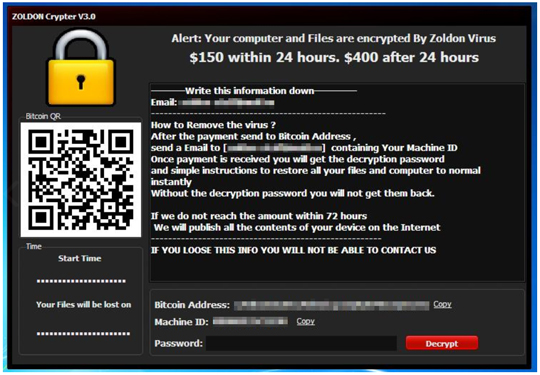RANSOM_ZOLDON.THHAOAH
Trojan-Ransom.Win32.Gen.kgx (KASPERSKY), a variant of Win32/Filecoder.NMJ trojan (NOD32)
Windows


Threat Type: Ransomware
Destructiveness: No
Encrypted: No
In the wild: Yes
OVERVIEW
Downloaded from the Internet
This Ransomware arrives on a system as a file dropped by other malware or as a file downloaded unknowingly by users when visiting malicious sites.
TECHNICAL DETAILS
1,430,528 bytes
EXE
Yes
10 Aug 2018
Displays message/message boxes, Encrypts files
Arrival Details
This Ransomware arrives on a system as a file dropped by other malware or as a file downloaded unknowingly by users when visiting malicious sites.
Autostart Technique
This Ransomware adds the following registry entries to enable its automatic execution at every system startup:
HKEY_CURRENT_USER\Software\Microsoft\
Windows\CurrentVersion\Run
Z0ldon = {malware path}
Other System Modifications
This Ransomware adds the following registry entries as part of its installation routine:
HKEY_CURRENT_USER\Software\Z0ldon
start = {date of malware execution}
Other Details
This Ransomware does the following:
- Displays the following as part of its ransomware routine:

- It encrypts files without appending an extension.
Ransomware Routine
This Ransomware leaves text files that serve as ransom notes containing the following text:
- %User Profile%\DesktopZoldon.txt

SOLUTION
9.850
14.434.02
10 Aug 2018
14.435.00
11 Aug 2018
Step 1
Before doing any scans, Windows XP, Windows Vista, and Windows 7 users must disable System Restore to allow full scanning of their computers.
Step 2
Note that not all files, folders, and registry keys and entries are installed on your computer during this malware's/spyware's/grayware's execution. This may be due to incomplete installation or other operating system conditions. If you do not find the same files/folders/registry information, please proceed to the next step.
Step 3
Restart in Safe Mode
Step 4
Delete this registry key
Important: Editing the Windows Registry incorrectly can lead to irreversible system malfunction. Please do this step only if you know how or you can ask assistance from your system administrator. Else, check this Microsoft article first before modifying your computer's registry.
- In HKEY_CURRENT_USER\Software
- Z0ldon
- Z0ldon
Step 5
Delete this registry value
Important: Editing the Windows Registry incorrectly can lead to irreversible system malfunction. Please do this step only if you know how or you can ask assistance from your system administrator. Else, check this Microsoft article first before modifying your computer's registry.
- In HKEY_CURRENT_USER\Software\Microsoft\Windows\CurrentVersion\Run
- Z0ldon = {malware path}
- Z0ldon = {malware path}
Step 6
Search and delete these files
- %User Profile%\DesktopZoldon.txt
Step 7
Restart in normal mode and scan your computer with your Trend Micro product for files detected as RANSOM_ZOLDON.THHAOAH. If the detected files have already been cleaned, deleted, or quarantined by your Trend Micro product, no further step is required. You may opt to simply delete the quarantined files. Please check this Knowledge Base page for more information.
Step 8
Restore encrypted files from backup.
Did this description help? Tell us how we did.

